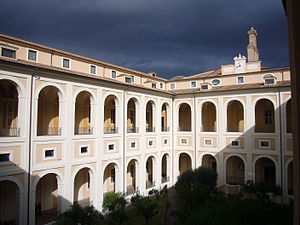San Michele a Ripa
| Monumental complex of San Michele a Ripa Grande | |
|---|---|
| Complesso monumentale di San Michele a Ripa Grande | |

The Courtyard of the Old Men
|
|
| General information | |
| Location | Rome, Italy |
| Current tenants | Ministry of Cultural Heritage and Activities |
| Construction started | 1686 |
| Completed | 1834 |
| Owner | State ownership |
| Design and construction | |
| Architect | Carlo Fontana, Mattia De Rossi, Giacomo Recalcati, Nicola Michetti, Ferdinando Fuga, Nicolò Forti, Luigi Poletti |
The Ospizio di San Michele a Ripa Grande (Hospice of St Michael) or Ospizio Apostolico di San Michele in Rome is represented today by a series of buildings in the south end of the Rione Trastevere, facing the Tiber River and extending from the bank of Ponte Sublicio for nearly 500 meters. It stands across the river from the Rione Ripa and the area known as the Porto di Ripetta, once in the Aventine neighborhood of Rome. The Porto di Ripa Grande was the river port that served those coming up from the Mediterranean port of Ostia. This area was once a main port of Rome. While large seafaring ships could not forge easily up the Tiber river to Rome; smaller boats frequently brought supplies from the coast to the city and offloaded at the Porta.
The buildings of the Ospizio di San Michele were built during the 17th and 18th centuries and served a number of purposes including an orphanage, a hospice for abandoned elderly, and jails for minors and women. In 1679, a nephew of the new Pope Innocent XI (reigned 1676 -1689), Monsignor Carlo Tommaso Odescalchi commissioned architect Mattia de Rossi to design, and within five years had built an hospice to house and train orphan children to manufacture of woven carpets and tapestries. To this building were added in 1693, the Ospizio dei Poveri Inabilito (disabled poor), and in 1709, Pope Clement XI commissioned the architect Carlo Fontana to extend the complex even further and transferred the elderly residents here from the Ospedale dei Mendicanti, located in the Via Giulia. Later additions to the building were the prison for minors and an art school. In 1735, Pope Clement XII commissioned architect Ferdinando Fuga to design a woman’s prison and a barracks for customs officers.
The Chiesa Grande, also known as the San Salvatore degli Invalidi, follows a design (1706) of Carlo Fontana, but construction was completed only in 1834 by Luigi Poletti. It has been reconsecrated. The church has an aedicula with a statue of the Saviour by Adamo Tadolini.
...
Wikipedia
